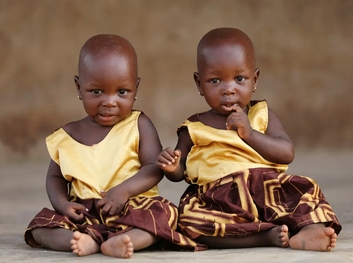
support@yorubalibrary.com
+2348073529208, 07038599574

In the magnificent drama of twin birth, the arrival of the second child is a moment of importance. This is not merely the appearance of another baby, but the fulfillment of a mission. This child is named Kehinde (also spelled Kéhìndé). While eternally connected to their twin, Kehinde embodies a complete and powerful identity of their own. This is the story of the sovereign, the wise spirit who waited for the signal, confirming their trust in their sibling before gracing the world with their presence.
The Meaning of the Name Kehinde
The name Kehinde is derived from the Yoruba phrase "Omo kehin dé," which translates to "The child who comes behind has arrived."
To interpret this as merely "the younger one" is to miss its deep spiritual meaning. Yoruba tradition holds that Kehinde is, in fact, the senior partner in spirit and wisdom. It was Kehinde who sent Taiwo on the initial reconnaissance mission to inspect the world. Kehinde's position signifies patience, strategic thinking, and a judicious nature. They awaited the report before committing to the journey. This makes Kehinde's entrance one of deliberate action, trust, and inherent authority.
The Unique Character of a Kehinde Child
A child named Kehinde, even when raised alone, is believed to carry the core characteristics of their destined role. These traits form the foundation of their spirit.
• The Thoughtful Strategist:
A Kehinde child is often observant. They may learn by watching, processing information internally before acting. They are not slow, but thorough, ensuring their actions are well-considered.
• The Old Soul with Innate Wisdom:
Believed to be the elder in spirit, a Kehinde child often displays a maturity that seems beyond their years. They can be perceptive, offering surprising insights and demonstrating a quiet understanding of people and situations.
• The Calm and Patient Presence:
While Taiwo embodies action, Kehinde embodies patience. They possess a calming energy and are often less impulsive, able to wait for the right moment to engage.
• The Holder of Legacy:
Kehinde is often regarded as the child who carries the deeper spiritual lineage of the family. They are seen as the anchor, the one who maintains tradition and possesses a strong connection to their roots.
Nurturing a Kehinde's Spirit
Raising a Kehinde child involves honoring their contemplative nature and guiding their innate wisdom.
1. Value Their Process:
Allow Kehinde the time and space they need to observe and think before participating. Avoid forcing them into the spotlight immediately; let them engage at their own pace.
2. Engage Their Depth:
Have meaningful conversations with them. Ask for their opinion and truly listen to their responses. This validates their inherent wisdom and shows that their thoughtful perspective is valued.
3. Provide a Stable Foundation:
Kehinde children, as the spiritual anchors, thrive in environments of stability and calm. Consistent routines and a peaceful home life provide the security they need to flourish.
4. Celebrate Their Quiet Strength:
Do not mistake their quietness for shyness or a lack of courage. Celebrate their strength as strategists and thinkers. Help them understand that their power lies in their depth and perception, not just in outward expression.
The Oriki of Kehinde (The Second-Born Twin)
Check out the specially dedicated eulogies for Omokehinde
Omo Kehinde egbon ejire
Ejire Oyilaki
Olode Ajiworan
Ara Deure
Ara Igbodo Ajagaase
O-toko-bo-se-bi-ara-ile
Bi a ba n k'ejire
Ka ma ya ti Kehinde soto
Bi eeyan o ki Kehinde dele
Oluware yoo te'ko
A-ji-ma-je-nnkan-to-leegun
Iran edun o gbodo jeran ega
Edunjobi Ejire
Omo iku leegun
Oyilaki figbin bori re ni kutu kutu
Conclusion:
A child named Kehinde is a reminder that true strength is often found in patience, wisdom, and strategic action.
Need more? Browse through our Oriki Gallery today, at zero cost.

Your baby was born with locked hair? Learn about t…

Curious about Yoruba twin names often called Ibeji…